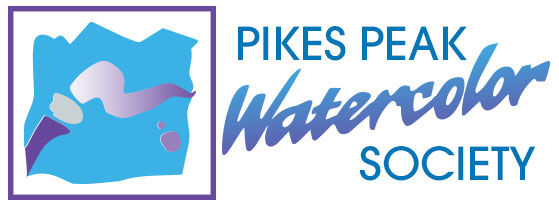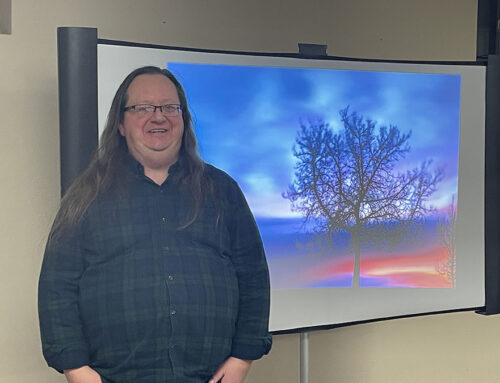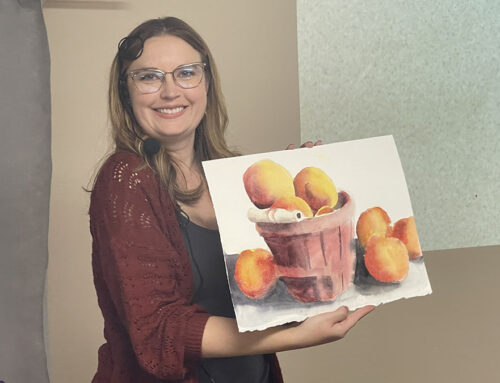The Artist’s Palette: the Rare, the Precious, the Poisonous and the Fugitive.
Cindi Zenkert-Strange, our October speaker and presentation was just fascinating!
She gave a very in depth presentation on the history of paint colors or Roy-G-Biv, an acronym for the sequence of hues commonly described as making up a rainbow: red, orange, yellow, green, blue, indigo, and violet.
As Cindi went through each of the ROYGBIV paint colors, she told us the history of each color, where or how it was made and quite a few interesting stories, some rather funny, about each color.
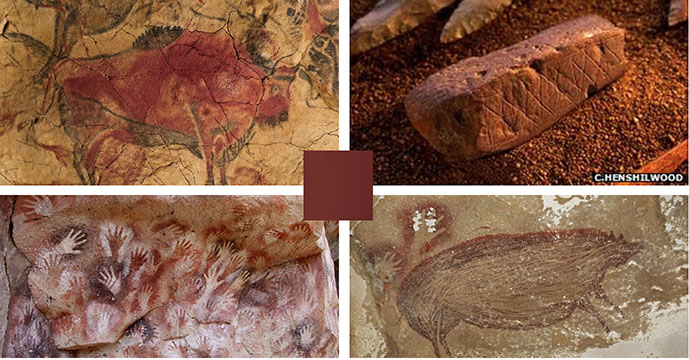
Red Ochre
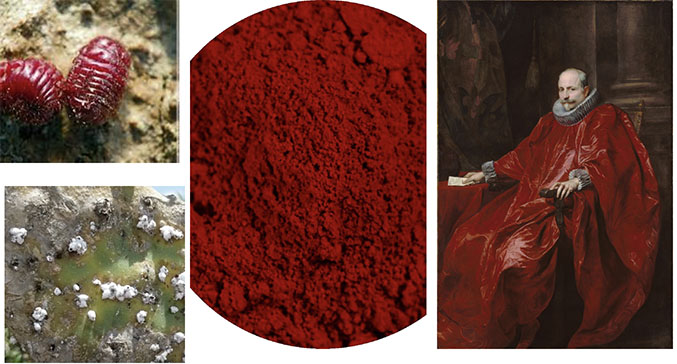
Cochineal Red
The Reds
- Red Cchre has been found in the famous Paleolithic cave paintings of Lascaux in France, dating back 14,000 years!
- Vermillion, the primary red pigment sud by European painters from the Renaissance to the 20th Century.
- Warm Red or Red Lead, a very warm red that was highly toxic!
- Kermes Red, or Crimson was made from lice found on oak trees. It took 2400 bugs to make one once of pigment!
- Cochineal Red, made from an insect, it took 80,00 to 10,000 to produc one kiol of dye!
- Dragon’s Blood, rumored to be made from mixing the blood of elephants and dragons!
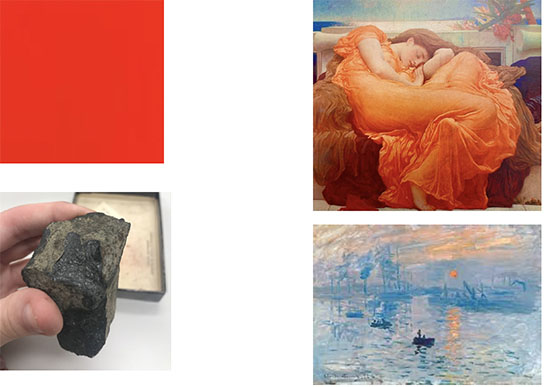
Crome Orange
The Oranges
- Orpiment, an early organge pigment that was a volcanic mineral.
- Saffron, derived the stigmas of the crocus flower. One pound uses 50,000 to 80,000 flowers, and is very expensive.
- Chrome Orange, an orange-rd mineral discoverd in Siberia in 1762.
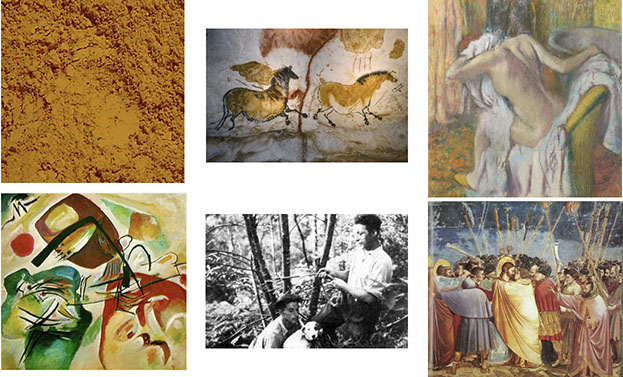
Yellow Ochre
The Yellows
- Yellow Ochre, come from the Greek word for pale earth.
- Indian Yellow, supposedly made from the urine of cows fed mango leaves!
- Gamboge was made from trees found in SE Asia.
- Chrome Yellow was also know as Zinc Yellow.
their history, how they were made, some with bugs or insects! A few of these colors were very toxic and Scheele’s Green contained arsenic!
As Cindi went through each of the ROYGBIV paint colors, she told us the history of each color, where or how it was made and quite a few interesting stories, some rather funny, about each color.
One color, Tyrian Purple, beloved by the ancient Phoenicians, required 10,000 sea snails to produce a single gram of pigment! Another color, Emerald Green, discovered in 1814 was first used to kill sewer rats in Paris!
Cindi is a retired writer and grant manager. She was a docent for 25 years at the Indianapolis Museum of Art and the Colorado Springs Fine Arts Center and has lectured on a wide variety of art history-related topics. Sadly, she is NOT an artist!
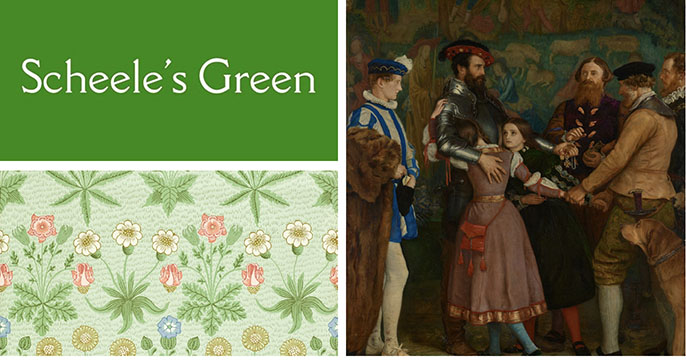
Scheele’s Green
The Greens
- Terre Verte Green Earth
- Malachite is a naturally occurring mineral and was popular in Asia.
- Verdigris was used in ancient Egypt as eye paint!
- Scheele’s Green was very toxic and found to contain arsenic!
- Emerald Green was a dazzing green, but also toxic and was used to kill sewer rats in Paris!
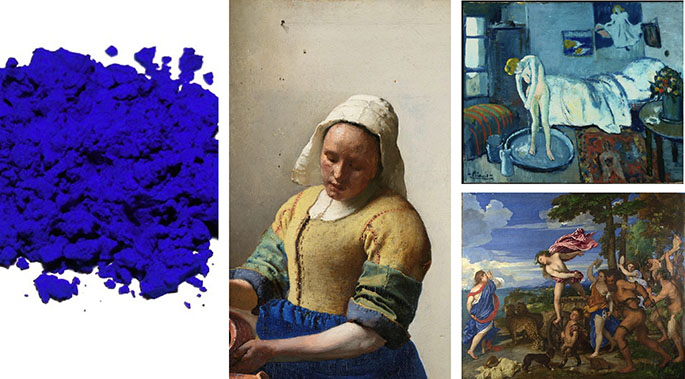
Ultramarine Blue
The Blues
- Egyptian Blue dates back to about 2200 BC!
- Ultramarine Blue earliest use was found in cave temples in Afghanistan from the 6th century.
- Woad, made from a plant found in Europe was used as a dye and face paint.
- Indigo was also made from a plant and was found in Egyptian tombs.
- Prussian Blue was invented by mistake in 1704!
- Cobalt Blue was discovered in 1803.
their history, how they were made, some with bugs or insects! A few of these colors were very toxic and Scheele’s Green contained arsenic!
As Cindi went through each of the ROYGBIV paint colors, she told us the history of each color, where or how it was made and quite a few interesting stories, some rather funny, about each color.
One color, Tyrian Purple, beloved by the ancient Phoenicians, required 10,000 sea snails to produce a single gram of pigment! Another color, Emerald Green, discovered in 1814 was first used to kill sewer rats in Paris!
Cindi is a retired writer and grant manager. She was a docent for 25 years at the Indianapolis Museum of Art and the Colorado Springs Fine Arts Center and has lectured on a wide variety of art history-related topics. Sadly, she is NOT an artist!

Tyrian Purple
The Purples
- Tyrian Puple took more than 250,000 sea snails to make one ounce of dye!
- Cobalt Violet was made by a French chemist and Monet said, “I have finally discovered the true color of the atmosphere!”
- Perkins Purple or Mauvine was discovered by an 18 year old chemist trying to invent a drug to treat malaria.
Cindi is a retired writer and grant manager. She was a docent for 25 years at the Indianapolis Museum of Art and the Colorado Springs Fine Arts Center and has lectured on a wide variety of art history-related topics. Sadly, she is NOT an artist!
If your club or organization would like to hear Cindi’s fascinating and informative Pigment Presentation on the history of colors, contact us and we will send you her contact information.
